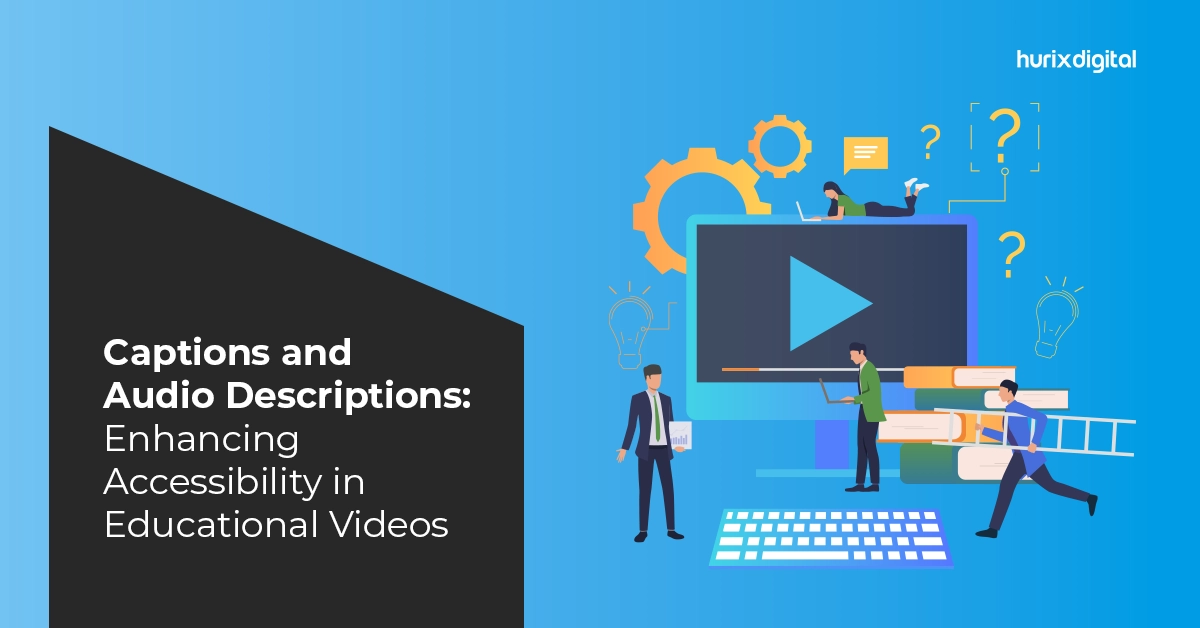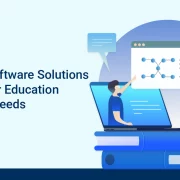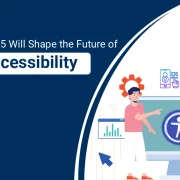
Captions and Audio Descriptions: Enhancing Accessibility in Educational Videos
Summary
This post explores how captions and audio descriptions enhance accessibility in educational videos. It explains the benefits of these features for students with disabilities and provides best practices for implementing them to make educational content more accessible to all learners.
Traditional learning methods fall short of meeting the breakneck pace of today’s competitive climate. The widespread access to information afforded by the internet has allowed us to implement new forms of learning, facilitated by visual and auditory elements, for a deeper understanding of the subject matter.
However, more complex learning materials also require accessibility in educational videos. This is especially true for people with learning disabilities or those who feel limited by a narrow selection of learning styles.
In this blog, we will explore how captions and audio descriptions enhance accessibility in educational videos, helping widen productive access to inclusive learning.
Table of Contents:
- The Importance of Accessibility in Educational Videos
- Captions for Inclusive Learning
- Audio Descriptions for Visual Content
- The Role of Educational Technology in Promoting Accessibility
- Implementing the Best Practices for Accessibility
- The Impact of Accessible Educational Videos
- Conclusion
The Importance of Accessibility in Educational Videos
Inculcating accessibility in educational videos allows educators to widen access to learning materials while simultaneously complying with any regulations regarding the spread of inclusive learning.
This inclusivity is essential, allowing diversity in learning needs and abilities to be recognized and respected. Captions and audio descriptions break down barriers and make educational content accessible to students with hearing or visual impairments.
Captions for Inclusive Learning
Captions are written transcriptions of spoken words and other important sounds in videos. They allow those who have trouble with their hearing to serve as an invaluable resource for inclusive learning.
Besides, captions help non-native speakers and those with learning difficulties understand the material without having to resort to less optimal methods of learning.
They provide the following benefits:
1. Improved Comprehension and Retention
Captions in educational content are beneficial for everyone. Apart from students who require them for prolific learning, all students can use captions to keep up with video content, keep better track of notes, and improve their reading comprehension and retention.
According to a report from the University of Florida, St. Petersburg, 42% of students use captions to improve their focus on learning material.
2. Support for Non-Native Speakers
In an increasingly globalized world, it is becoming more common to have classrooms filled with learners from diverse backgrounds, regions, and cultures. For non-native speakers, captions are a handy tool for catching up on information that might otherwise become confusing.
3. Flexibility and Convenience
As a facet of educational technology, captions allow students to engage with their learning material irrespective of their surrounding environment. Students who are living in noisier environments can use captions to keep learning without being interrupted. This makes educational videos more adaptive to student needs, instead of the other way around.
Also Read: Top 6 Reasons Why Your B2B Organization Should Care About Digital Accessibility
Audio Descriptions for Visual Content
Audio descriptions give spoken explanations of the visual components of videos. Students with low or blind eyesight especially benefit from this.
Audio descriptions broaden access to visual material by describing actions, situations, and important visual clues, promoting inclusive education.
They provide the following benefits:
1. Improved Storytelling
More than simply summarizing images, audio descriptions improve storytelling by giving visually challenged learners background information they might otherwise miss. This type of assistive technology helps every student follow the material and understand both spoken and demonstrated content.
2. Detailed Descriptions for Better Understanding
Every student can learn more from thorough descriptions. Audio descriptions can, for example, go into further detail on the setup, reactions, and outcomes of an experiment in a science video. Therefore, they enhance the overall educational experience. This attention to detail accommodates many learning styles and promotes inclusive learning.
3. Integration with Other Assistive Technologies
Screen readers and braille displays are two additional examples of assistive technology that can easily integrate with audio descriptions. With so many ways for students to access and interact with instructional material, this integration ensures a more holistic approach to disability support.
The Role of Educational Technology in Promoting Accessibility
Accessible educational videos are created and distributed in large part because of educational technology. Thanks to technological developments, creating excellent captions and audio explanations is now easier.
Therefore, these accessibility features are not an afterthought but an essential component of content creation.
1. Automated Tools for Captioning
Modern educational technology uses artificial intelligence in advanced automatic captioning technologies to produce captions quickly and precisely.
Teachers can now more easily achieve multimedia accessibility. These technologies have greatly shortened the time and effort needed to create captions, even if human supervision is still essential to guarantee accuracy.
2. Software for Audio Description
Audio description software allows for the quick production of audio explanations, ensuring that all students have access to visual material. Utilizing these tools, teachers may make sure that their videos follow any guidelines for inclusive education.
3. Customizable and Interactive Features
Educational videos can also include interactive elements that support inclusive learning. Students can, for example, change the background, text size, and color of the captions to ensure that they can read them however they like.
Interactive transcripts, with their multimodal approach to information processing, can also assist individuals with learning disabilities by highlighting text during speech.
Implementing the Best Practices for Accessibility
Using the best practices in the production and distribution of educational videos is essential. It ensures that these materials are actually accessible. This requires a holistic approach to disability support, not just the use of audio explanations and captions.
1. Inclusive Design from the Outset
Video production should start with accessibility in mind. This entails creating audio descriptions and captions ahead of time rather than as a last-minute addition. Using an inclusive design approach, all students can access the content that teachers provide.
2. Regular Reviews and Feedback
Audits of educational videos regularly can point out areas that need accessibility enhancement. Additionally, getting input from students who rely on these accessibility features is important. Their opinions can help guide changes and ensure that the resources meet their needs.
3. Information and Training
Educators and content producers must recognize the value of multimedia accessibility and receive training in the best ways to apply these elements. Teachers can acquire the necessary information and skills to create easily understood material through online courses, webinars, and other inclusive education materials.
The Impact of Accessible Educational Videos
The accessibility of educational videos has an effect that goes beyond individual students. It encourages an inclusive and diverse culture in educational institutions.
Institutions convey a powerful message that every student’s learning requirements are respected and supported by giving accessibility to educational videos first priority.
1. Promoting Equal Opportunity
All pupils have equal chances to achieve when educational videos are easily accessible. Institutions can enable every student to realize their greatest potential by eliminating obstacles to learning. A just and equitable educational setting depends on this dedication to inclusive learning.
2. Developing a More Inclusive Environment
Education is the primary factor in shaping society’s attitudes. An inclusive society is one that educational institutions help to create by giving inclusive education a top priority. Inclusion in the classroom increases students’ likelihood of bringing these principles into their personal and professional lives.
3. Improving Learning
Students with disabilities are not the only ones who benefit from accessibility features in educational videos. In terms of reading and comprehension, all students may benefit from captions, for example.
Audio descriptions can achieve a richer comprehension of the material, thereby improving the learning process in general.
Read Success Story: Hurix Digital Generates Alt-Text for 18,000 French eBooks for a Leading European Academic Publisher
Conclusion
The inclusion of captions and audio descriptions primarily determines accessibility in educational films. These technologies enable students with a range of needs and capacities to access content, therefore supporting inclusive learning. Developments in educational technology have facilitated the production of these accessibility elements, ensuring their essential role in the educational process.
Developing an accessible internet is a part we must all play, and at Hurix Digital, we recognize the significance of a user-friendly online representation. Our specialists excel at incorporating web accessibility functionalities to deliver an exceptional user experience for all individuals.
Contact us now!

Vice President – Digital Content Transformation. He is PMP, CSM, and CPACC certified and has 20+ years of experience in Project Management, Delivery Management, and managing the Offshore Development Centre (ODC).




